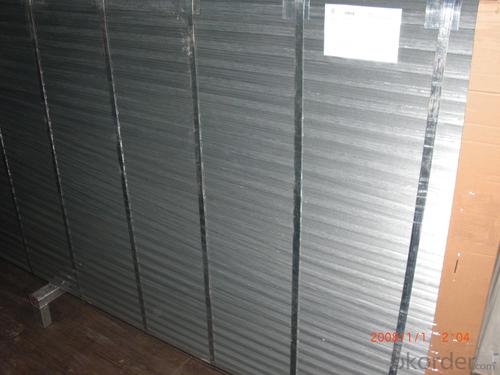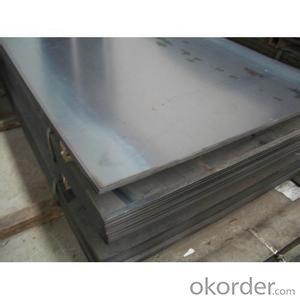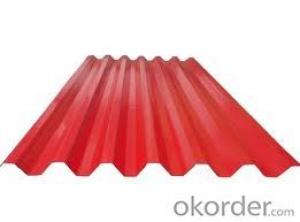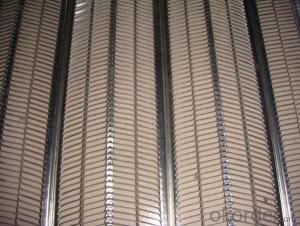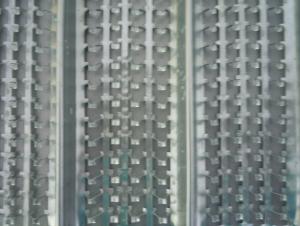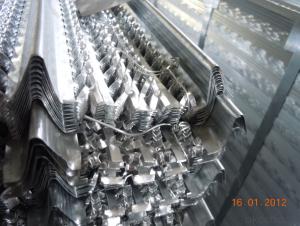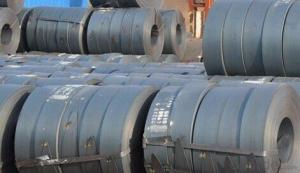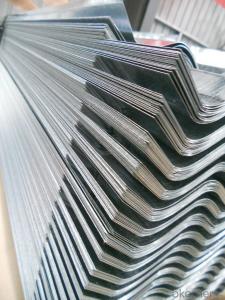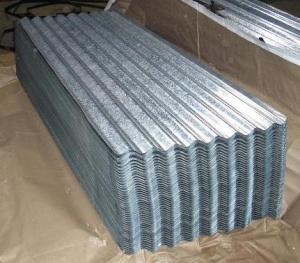GAVANIZED STEEL Rib Lath
- Loading Port:
- China Main Port
- Payment Terms:
- TT OR LC
- Min Order Qty:
- -
- Supply Capability:
- -
OKorder Service Pledge
OKorder Financial Service
You Might Also Like
GAVANIZED STEEL rib mesh is made of hot-dip zinc coated steel sheet,
It is used to be the material of untake out formwork for concret, widely used as plaster backing on ceilings, walls and stud partitions. Rib Lath is also ideal for refurbishing damaged or aged masonry walls when a key for rendering is not certain due to disintegration or softening of the wall face.
Application:
Construction formwork mesh has very good engineering quality and construction security;
Construction formwork mesh as the concrete permanent assembly
free sheet is much convenient for engineering design and processing;
Construction formwork mesh is widely used in tunnels,bridges and valve system and so on to make the process of construction much more fast and stable.
ZINC COATING: G40 WEIGHT: 4.2KG/SHEET
- Q: Can steel sheets be used for architectural applications?
- Yes, steel sheets can be used for architectural applications. Steel sheets offer several advantages such as strength, durability, and versatility, making them suitable for a wide range of architectural purposes like roofing, cladding, and structural elements. Additionally, steel sheets can be customized in terms of size, shape, and finish, allowing architects to achieve their desired design aesthetics.
- Q: What is the difference between a laminated and non-laminated steel sheet?
- A laminated steel sheet is formed by layering multiple thin sheets of steel together, while a non-laminated steel sheet is made from a single solid piece of steel. The lamination process enhances the strength and durability of the sheet, making it more resistant to bending, warping, and corrosion. On the other hand, non-laminated steel sheets are generally less expensive and may be easier to work with due to their uniform composition.
- Q: Can steel sheets be used in the food processing industry?
- Yes, steel sheets can be used in the food processing industry. Steel is a popular choice for food processing equipment and materials due to its strength, durability, and corrosion resistance. It is commonly used in the construction of food storage tanks, conveyor belts, cutting surfaces, and other machinery. Additionally, steel sheets can be easily cleaned and sanitized, making them suitable for maintaining high hygiene standards in food processing facilities.
- Q: What kind of steel plate is Q234?
- Q235 is divided into four quality grades. They are Q235A, Q235B, Q235C, Q235D. The elements of iron and phosphorus in the steel increased in turn.
- Q: What is the average thermal conductivity of steel sheets?
- The thermal conductivity of steel sheets can differ based on multiple factors, including the specific type or grade of steel, its composition, and temperature. However, on average, steel sheets have a thermal conductivity ranging between 15 and 30 Watts per meter-kelvin (W/m·K). This signifies their effectiveness in conducting heat and facilitating the efficient transfer of thermal energy across their surfaces. It should be emphasized that the precise thermal conductivity of a particular steel sheet can be determined through laboratory testing or by referring to the manufacturer's technical specifications.
- Q: Can steel sheets be used for kitchen countertops?
- Yes, steel sheets can be used for kitchen countertops. Steel countertops are durable, heat resistant, and easy to clean, making them a popular choice for modern kitchens.
- Q: What's the corrosion resistance of hot-dip galvanized steel sheet?
- The corrosion resistance of galvanized steel sheet in natural environment is acceptable. The biochemical pond in the sewage treatment plant is strong in acidity, and the zinc is not acid resistant. It is very different from the galvanized sheet with the uncoated steel sheet.
- Q: Can steel sheets be used in the telecommunications industry?
- Yes, steel sheets can be used in the telecommunications industry. Steel sheets are commonly used for various applications in the telecommunications industry due to their strength, durability, and ability to protect sensitive equipment. They are often used to manufacture communication towers, antenna mounts, equipment cabinets, and enclosures. Steel sheets provide structural support and can withstand harsh environmental conditions such as strong winds, extreme temperatures, and heavy loads. Additionally, steel sheets can be easily fabricated and customized to meet specific requirements, making them a popular choice in the telecommunications industry.
- Q: Can steel sheets be customized in terms of thickness?
- Yes, steel sheets can be customized in terms of thickness. Steel sheets are manufactured in various thicknesses to cater to different applications and requirements. The thickness of a steel sheet can be customized during the manufacturing process according to the specific needs of the customer. This customization allows for versatility and flexibility in using steel sheets for a wide range of purposes, from construction and automotive industries to manufacturing and fabrication processes. Customizing the thickness of steel sheets ensures that they meet the specific strength, durability, and structural requirements of the project at hand.
- Q: What factors affect the cost of steel sheets?
- Several factors affect the cost of steel sheets, including the current market demand and supply, raw material prices, manufacturing and processing costs, transportation and logistics expenses, as well as any applicable trade tariffs or taxes. Additionally, factors such as the type and quality of steel, size and thickness of the sheets, as well as any special finishes or coatings required, can also impact the overall cost.
Send your message to us
GAVANIZED STEEL Rib Lath
- Loading Port:
- China Main Port
- Payment Terms:
- TT OR LC
- Min Order Qty:
- -
- Supply Capability:
- -
OKorder Service Pledge
OKorder Financial Service
Similar products
Hot products
Hot Searches
Related keywords



